Canna garden is a prominent representative of the plant used in landscape design. Large oblong leaves are beautiful and decorate the composition before throwing out the peduncle arrow. And the abundant flowering on a high stem in different combinations of colors and shades will be the highlight of the site.

Canna is an amazingly beautiful, showy flower and is very loved by summer residents.
Use in garden landscaping
Content
- Use in garden landscaping
- Description and features of the plant - popular varieties
- Common varieties of cannes
- Canna garden: planting and care in the open field
- Reproduction
- Landing
- Care
- Recommendations for composing compositions with other colors
- VIDEO: Growing and caring for a cannabis in the garden.
- Photo examples of the design of garden beds with cannes:
In the design of mixborders, rabatki and flower beds, the garden cannes flower is assigned the center of the composition. Exotic inflorescences can decorate rocky approaches to water sources and become the center of a trimmed lawn as a stand-alone composition.
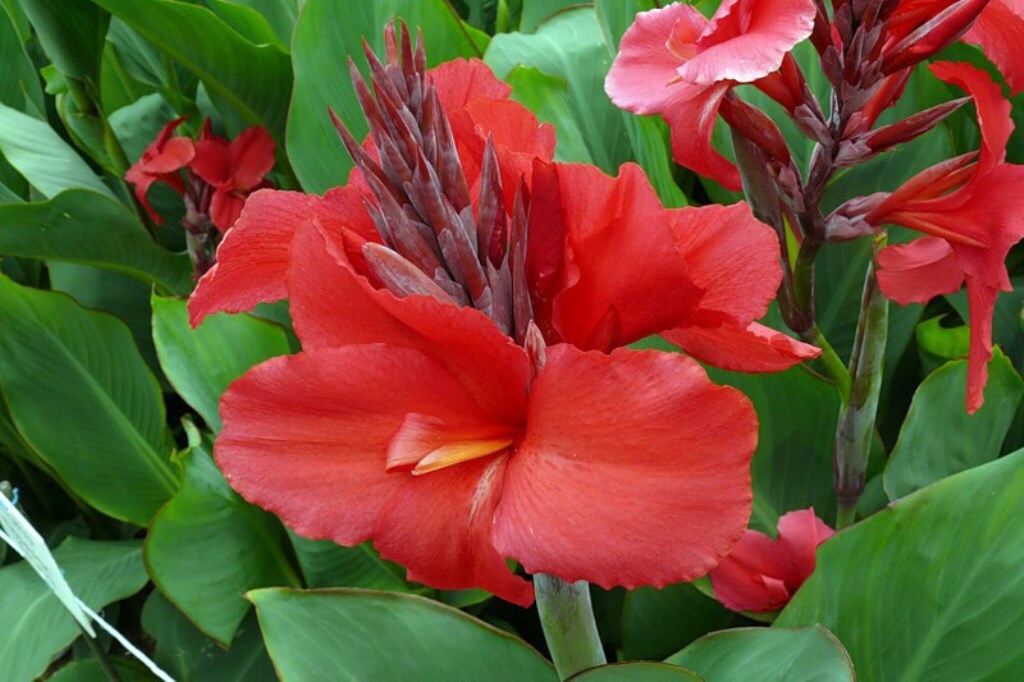
The high popularity of the plant is due to its good survival rate, a long flowering period and the unpretentiousness of the flower.
The plant loves humid air, so it blooms in lush flowers next to swamps and ponds.
Unpretentiousness and an extensive root system allows you to combine cannes with any representatives of plants used for growing in flower beds.
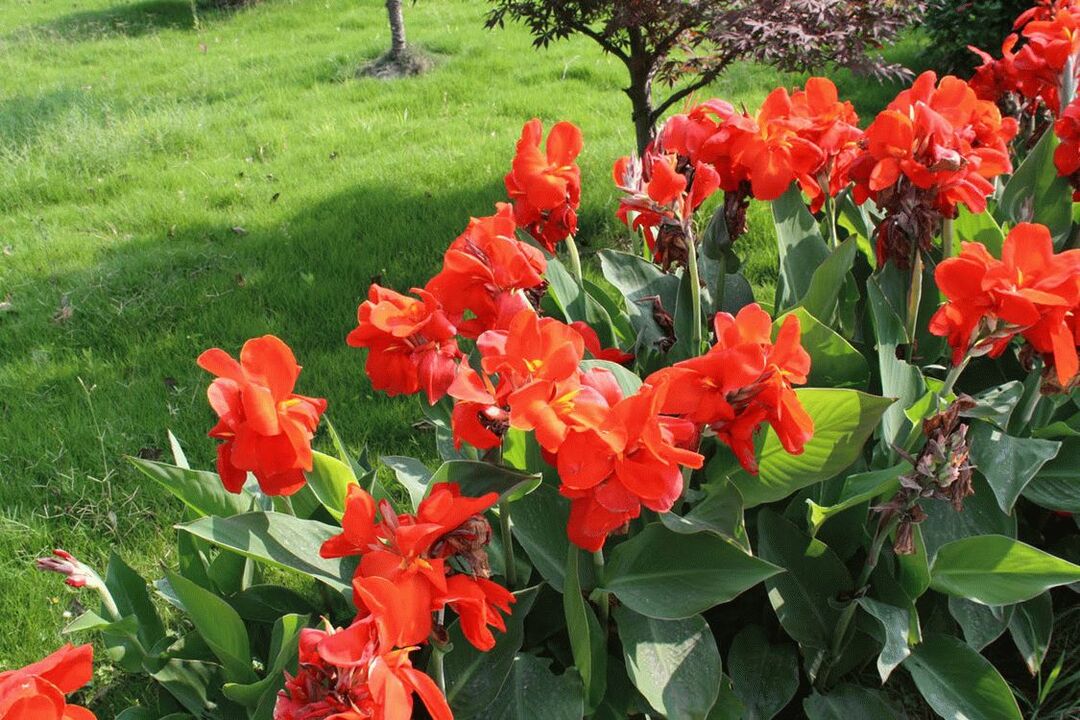
Kanna (from lat. Canna) is the only member of the canna family (from lat. Cannaceae) and belongs to the order of the gingerbread.
The main thing that is required from neighboring species is the tolerance of the shade provided by the extensive foliage.
Cannes are often used to create cascading compositions planted along the house, fence or around the gazebo. Where tall cannes are the main accent, which is formed along a cascade of undersized flower groups.
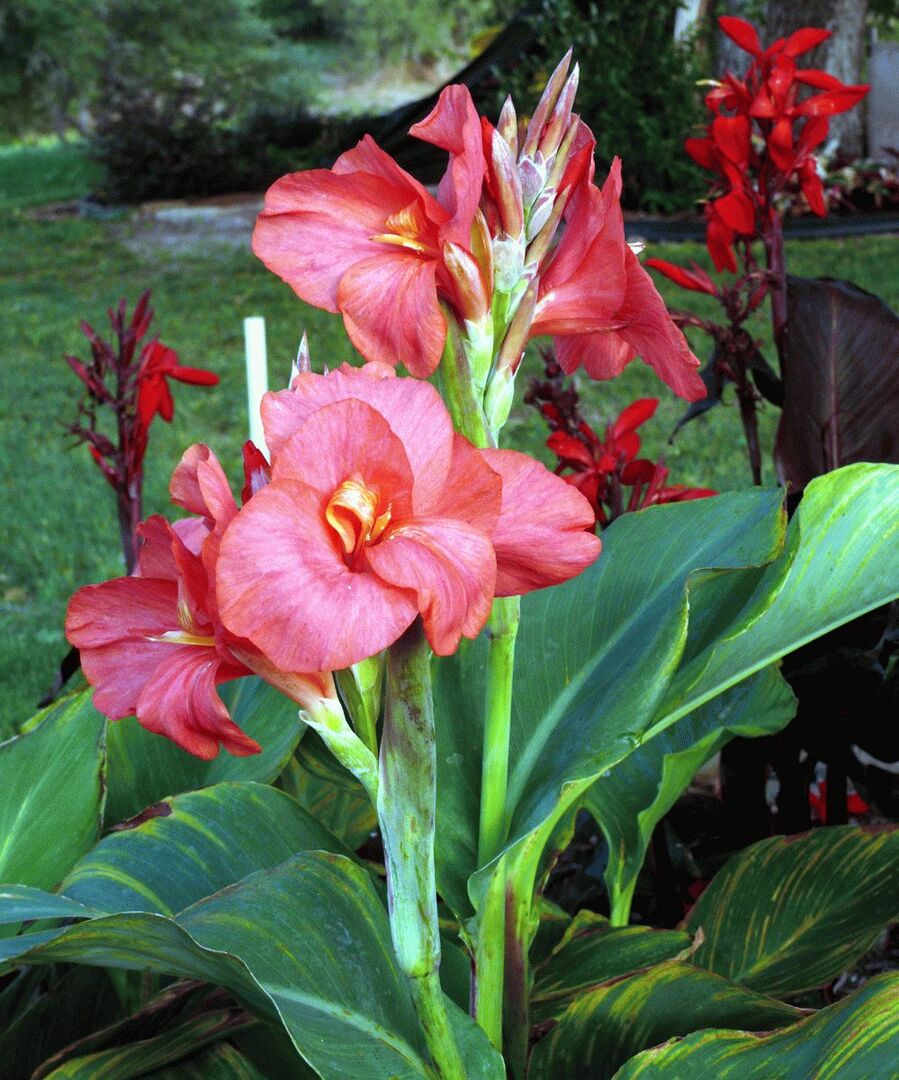
Possessing excellent adaptive qualities, the flower quickly adapts to different ecosystems and grows equally well along water bodies, in mountain gorges and on the coastal plains.
With the help of a tall plant, you can zone the site, mask unsightly views of the walls, or separate from neighbors with an original fence.
Low-growing species are planted in flowerpots or boxes to decorate balconies and terraces or recreation areas.
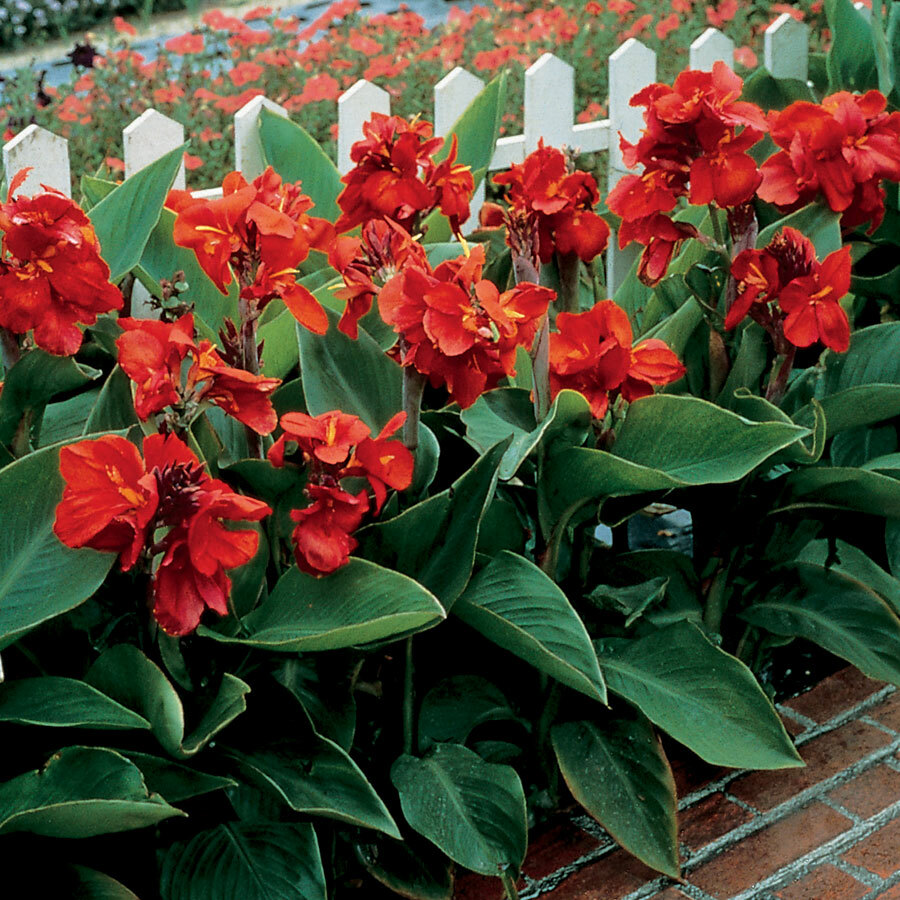
Canna is a perennial herb with large, two-row leaves and a branched root system.
Having appreciated the beauty of cannes in landscape design in the photo, many gardeners grow it not only on their plots, but also plant it at home for the winter. At home, the flower releases a peduncle arrow twice a month.
Description and features of the plant - popular varieties
Gardeners who prefer exotic plants in their plots often ask the question: how to care for a canna flower in the garden? Landscape designers appreciate the canna for its unpretentiousness, good survival rate and the beauty of inflorescences on a long stem.

As for color, wild varieties are only red, but artificially bred hybrids are presented in a wide variety of shades.
The flower is divided into three main types: crozy - a dwarf variety, deciduous with a juicy green and reddish color and orchid with large inflorescences.
Abundant juicy greenery with oblong large leaves 70-90 cm long and 15-20 cm wide and an arrow-peduncle reaching 3 meters, as a finishing touch, will decorate any area.

Canna is very actively used by landscape designers to decorate parks and squares, and is also grown as a home flower.
The flowers are large, 10-25 cm in diameter, somewhat reminiscent of gladioli and orchids, of various shades.
The main color of cannes is red, but there are many different combinations of red with yellow, beige, orange and white.

In addition to the decorative function, it also has practical benefits: the green parts of the plant are used as feed for livestock, and the rhizomes are a valuable source of starch.
Features of the plant:
- Loves abundant watering and sunny places;
- Poorly tolerates cold winters, needs to dig out roots for the winter;
- Grows quickly and tolerates vegetative propagation well;
- Not predisposed to diseases, insects-parasites do not like her;
- It blooms twice a month under favorable conditions;
- Flowering duration 12-16 weeks;
- Odorless.
When planting a plant in open ground in April-May, the canna will bloom in June, and will delight with beautiful buds until October. As the flowering ends on the arrow, it releases another, and so on until late autumn. Flowering ends with the formation of a capsule with large seeds that can be used for breeding.

Modern breeders love canna for its ease of growing, drought resistance, easy maintenance, fast growth, high resistance.
Common varieties of cannes
- Indian. Slow growing plant, reaching a height of 2 meters. Leaves are smooth, light green in color or with red veins, 50-70 cm long. The variety does not differ in abundant flowering, it is bred as a deciduous species. The flowers are pink, fawn and red, 10 cm in diameter.
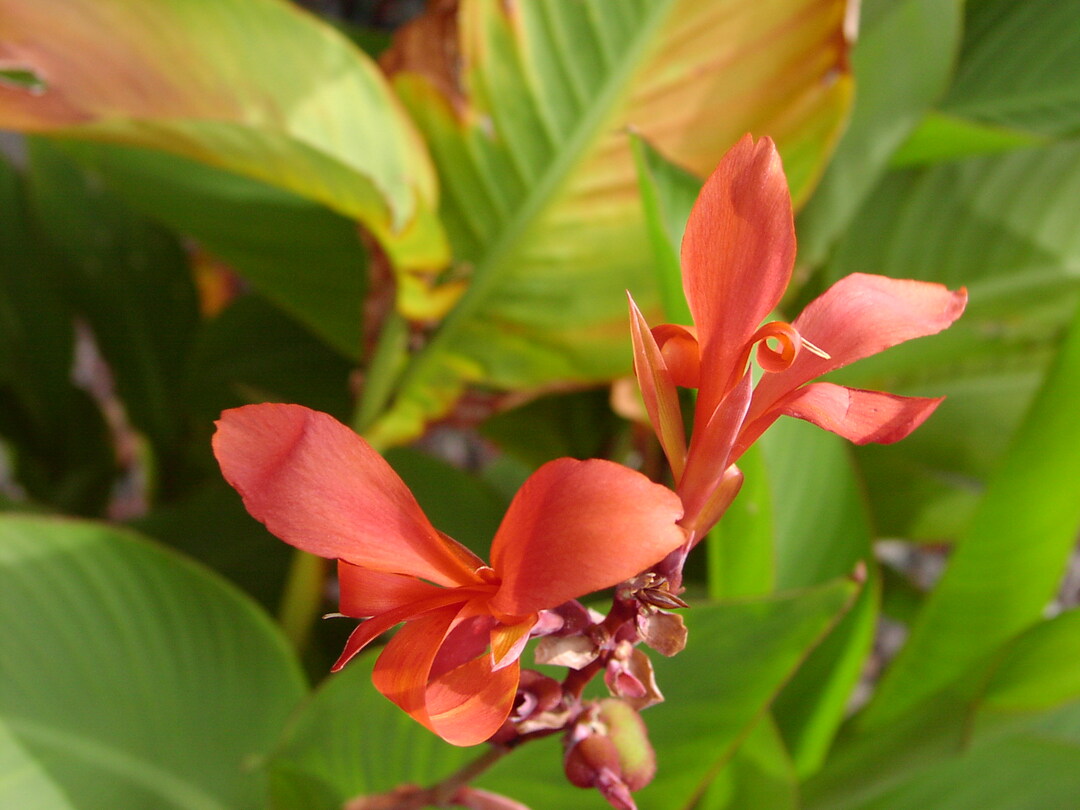
It is used for landscaping fences, gazebos and local area.
- Hanging. An evergreen species reaching a height of 1.2 meters. The leaves are narrow, 50-60 cm long and 13-15 cm wide, with a rich green hue. Flowers are grayish-yellow or red, 6-8 cm in diameter.

It is planted on the banks of reservoirs, for the design of pools and ponds.
- Low. Plant height up to 1.5 meters. The leaves are elongated, bright green, 50 cm long. It blooms profusely and in dense inflorescences with a combination of red, orange and yellow shades.

It is planted in flower beds in combination with other flowers and as a tapeworm on lawns and lawns.
The most popular varieties for growing in gardens are America, German Titov, Clara Buisson, Sunny Beauty, President and Livadia. They are distinguished by abundant flowering with large buds and unpretentiousness to cold weather. Bloom from early June to October.
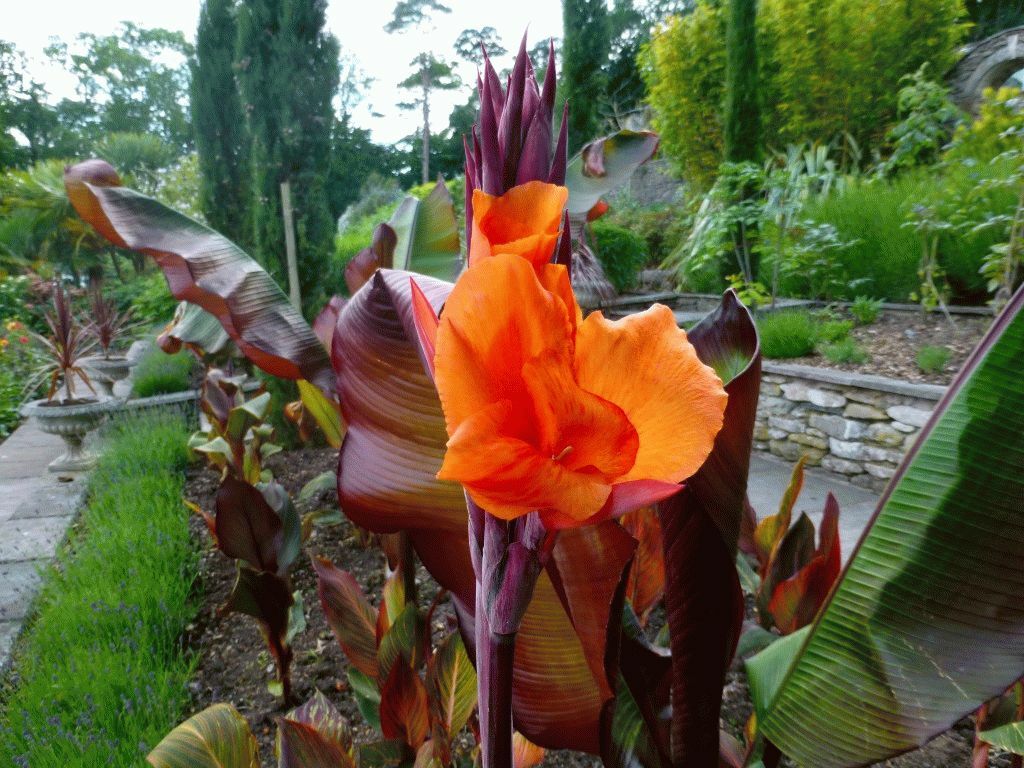
Recently, several varieties have been bred, which, in addition to gorgeous flowers, have a very unusual leaf shape, which only increases the attractiveness of the plant.
Canna garden: planting and care in the open field
The unpretentiousness and beauty of canna flowers when planting and caring in the garden makes the plant the center of many sites, greenhouses and conservatories. In frosty and snowless winters, the root of the best varieties is dug up and stored in basements and cellars.

Canna does not tolerate lower temperatures very well and often dies from hypothermia.
Numerous plantings along fences and houses are covered with a cloth and covered with snow from freezing. The plant does not tolerate winter well and may partially freeze out, but in the spring abundant foliage grows from the surviving roots and over the summer it is replenished.

If everything is done correctly, the tubers will be perfectly preserved until spring and will sprout quickly.
Reproduction
The flower is propagated more often vegetatively by dividing the roots. A part of the root with two or three developed buds is separated and planted in open ground in April-May.
When dividing in the fall, the root is kept in a mixture of one part of peat, turf, sand and sawdust until spring in a cold place with a temperature of + 5-10 degrees.

Canna can be propagated in two ways: by seeds and by dividing the bush.
At home, the plant can be grown from seeds formed in a capsule after flowering. Seeds are planted in February, when the plant grows to 15-20 cm and gets stronger, planted in the ground.
Landing
For landing, the place is chosen open and sunny. The flower grows quickly, so the distance between plants is 30-70 cm, depending on the variety. The soil should be fertilized with humus 4-5 kg per 1m. square. Loose, for this, sand is added to the planting hole. In dry summers, the soil is mulched with sawdust to avoid drying out and poor foliage formation.

When planting cannes in the garden, you must choose the right site, taking into account the ability of the flower to grow strongly in width.
Care
Moderate but regular watering during plant formation and abundant during flowering. The plant responds well to mineral fertilizing 2-3 times per flowering season. Not susceptible to diseases, but from excessive watering and rainfall, gray rot and rust on the leaves can appear. For removal, spraying with antifungal drugs is used.
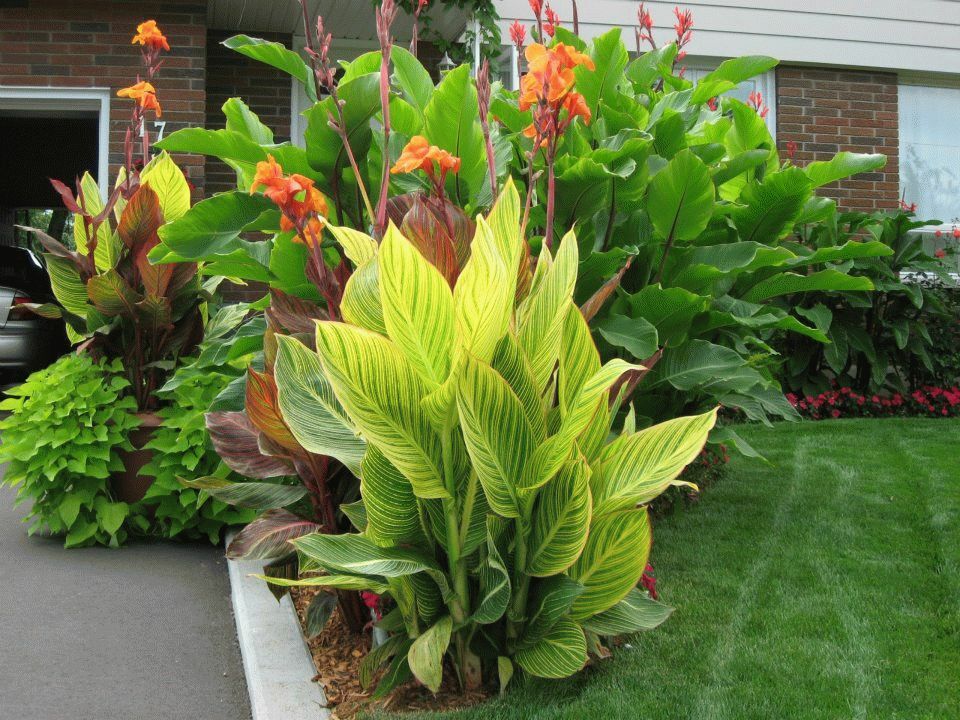
Cannes are highly decorative and are perfectly combined with undersized coleus, seaside wild rose, cerastium, undersized dahlias and marigolds.
After flowering, watering is limited to a minimum and the peduncles are cut off. For storage in the basement: they dig it up in October before the onset of frost, cut off the stem, leaving 10-15 cm, and put it in wooden boxes with a nutrient mixture until spring.
Amateurs recommend how to care for a canna flower in the garden - this is a uniform planting without thickening away from bushes of berries and fruit trees. The large root system of these plants will suppress each other and inhibit development.

Large varieties look good as single plantings, while smaller varieties are ideal for growing in flowerpots.
Recommendations for composing compositions with other colors
Abundant foliage with a long stem looks good with low-growing plants - these are marigolds, petunias and pelargoniums. When juicy foliage is set off by small and abundant multi-colored flowering.
An ideal combination is a composition of the same cannes of different types and colors in the middle of the plot, when the tallest specimen grows in the middle, and undersized at the edges.

There are many varieties of these flowers, each of which boasts its own color and shape of petals and leaves.
A freestanding plant will complement and decorate with morning glory, glistening rudbeckia and coleus with small inflorescences.
In pot compositions, the plant feels good next to ornamental pepper and croton.

The species is excellent for border and flowerpot cultivation and is distinguished by a very long flowering, lasting from June to late autumn.
Look at the photo of the canna flower in the garden, this royal plant does not require special additions and looks great as growing separately. But when decorating flower beds, it perfectly coexists with all representatives of undersized flowers.

With the queen of the garden, you can experiment in combinations and find your ideal composition, which will decorate the site.
VIDEO: Growing and caring for a cannabis in the garden.
Photo examples of the design of garden beds with cannes:




